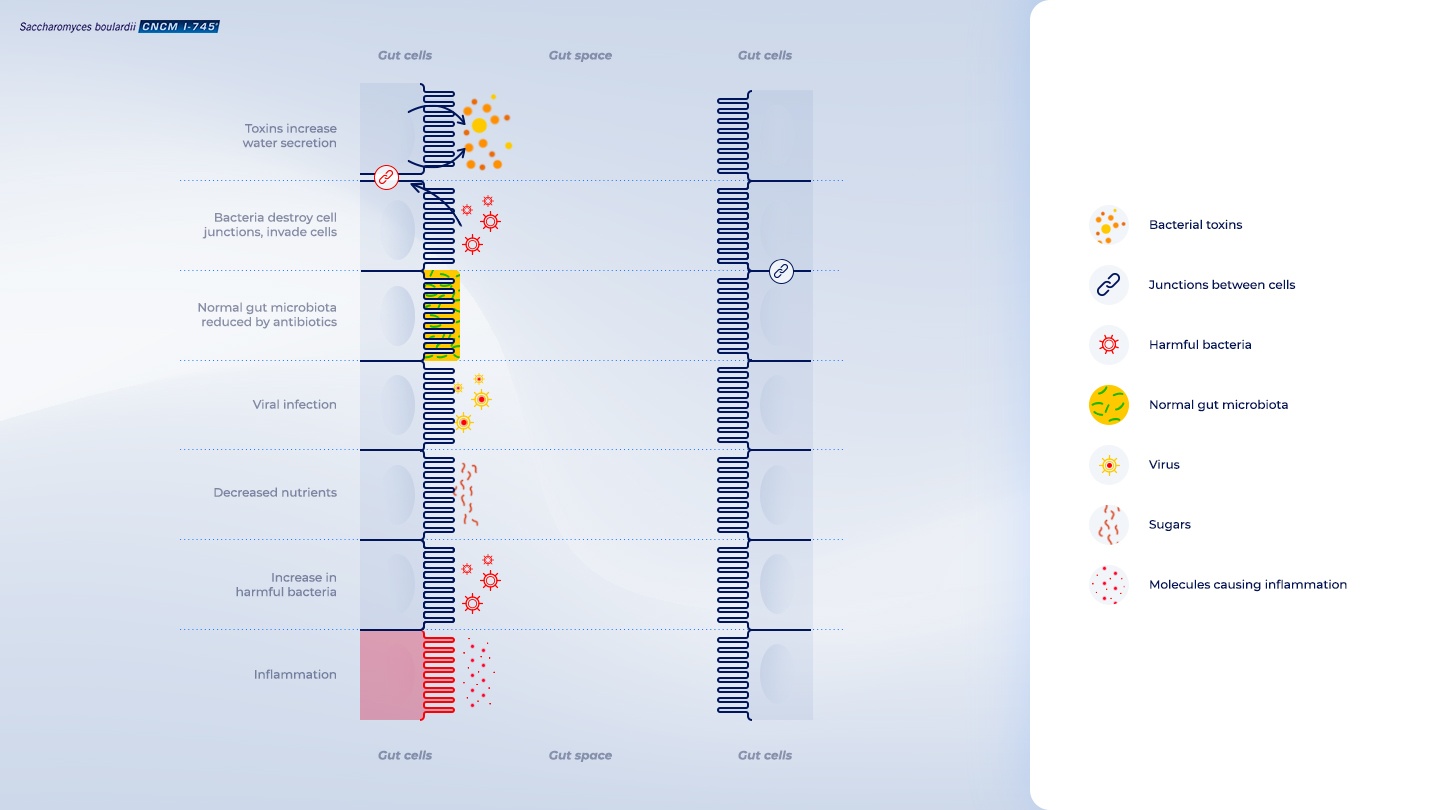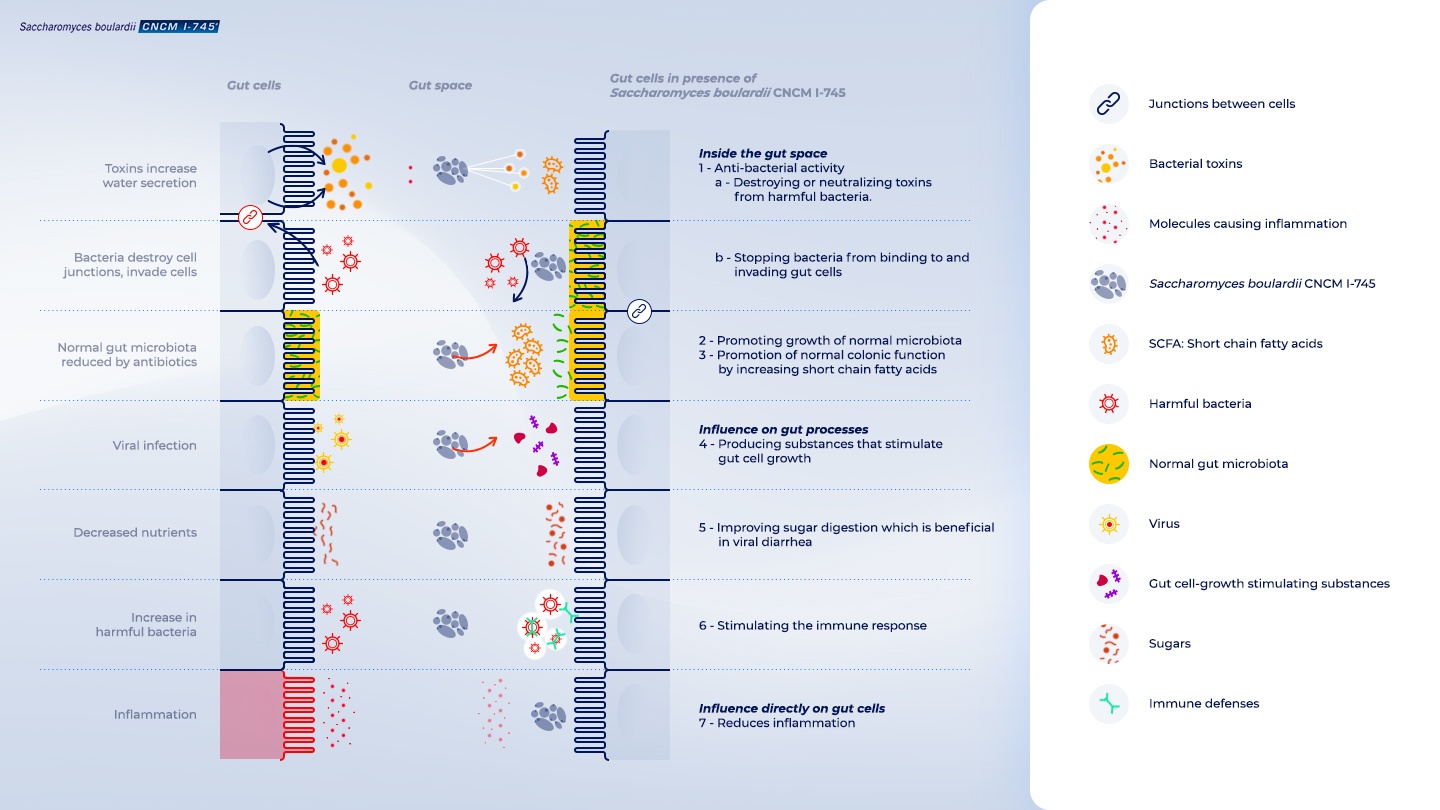The yeast probiotic Saccharomyces boulardii CNCM I-745 has multiple mechanisms of action for addressing diarrhea
- Video
- 4 min
Saccharomyces boulardii CNCM I-745 targets the causes of diarrhea thanks to multiple mechanisms of action
When you have an “upset” stomach, this is an indication that your bowel might not function properly.1
This can be due to harmful microbes such as bacteria or viruses causing damage to the lining of your gut2, or because the microbiota that live in your gut and help keep normal healthy gut functioning have been disturbed, either by the infection or by non-infectious reasons such as antibiotics.1 The disruption to your gut microbiota is called dysbiosis (an imbalance).1 When the gut microbiota balance has been disturbed, the subsequent knock-on effect could be diarrhea.1
The diarrhea can result from too much water being drawn into the gut, as can happen from virus and bacterial infections.2 It can also occur from a disrupted microbiota that insufficiently metabolizes minerals, carbohydrates and other nutrients that are usually a source of nutrition for the normal gut microbiota, remaining in the gut along with water.1 Also, inflammation can result from barriers between cells being damaged, which allows for electrolyte and water leakage.1

(Internal code : 20.60)
The positive effects of S. boulardii CNCM I-745 are numerous
One way to address the causes of diarrhea is by taking the yeast probiotic Saccharomyces boulardii CNCM I-745.1
S. boulardii CNCM I-745 has several properties that make it a good probiotic.1 a) when taken, it remains alive which means that it is actively creating a positive effect on the gut, b) has an optimal growth temperature of 37°C and c) a high tolerance to acid, such as found in the stomach.1 Another advantage is that it does not permanently stay in the gut.1 And, it is naturally resistant to the main prescribed antibiotics which means it can be taken at the same time as antibiotic therapy.1
The overall effect of S. boulardii CNCM I-745 is multiple: either indirectly or directly, it improves the growth environment for the normal gut microbiota, which improves the health of the gut.1
The yeast improves the environment by restoring the balance of microbiota, strengthens the intestinal immune system and anti-microbial activity as well as improves the gut function.1
- Stimulates the immune system to help the body destroy the harmful bacteria.2
- Secretes molecules that produce an anti-inflammatory effect that reduces the amount of, and symptoms of, inflammation in the gut.3
- Produces molecules that neutralize bacterial toxins such as cholera toxin, Clostridium difficle toxins, or Escherichia coli toxins.2
- Interferes with harmful bacterial strains to stop them from attaching to and invading the gut cells.2 It has also been reported that S. boulardii CNCM I-745 can prevent the growth of some harmful bacterial strains.2
- Produces substances that have a positive effect on the gut cells, stimulating improved growth as well as function.3

(Internal code : 20.60)
By preventing the loss of microbiota through diarrhea and the overgrowth of harmful bacteria, S. boulardii CNCM I-745 treatment leads to a quicker restoration of the normal gut microbiota.1
These multiple mechanisms of action support the use of S. boulardii CNCM I-745 as a therapeutical probiotic2, and unlike other probiotics, it has a very broad efficacy in many different situations that can result in diarrhea.1
Internal code : 20.26
References
- 01 . More MI, and Swidsinski, A. Saccharomyces boulardii CNCM I-745 supports regeneration of the intestinal microbiota after diarrheic dysbiosis–a review. Clinical and experimental gastroenterology. 2015; 8: 237.
- 02 . McFarland, LV. Systematic review and meta-analysis of Saccharomyces boulardii in adult patients. World journal of gastroenterology: WJG. 2010; 16(18): 2202.
- 03 . Joly, F et al. 2017. Saccharomyces boulardii CNCM I-745. Marteau, P and Dore J (Ed.), Gut Microbiota: A full-fledged organ. 2017: 305-326. Paris: John Libbey Eurotext. Gut Microbiota Book.
